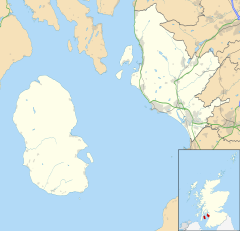Largs
Largs
|
|
|---|---|
 |
|
| Largs shown within North Ayrshire | |
| Population | 11,241 |
| OS grid reference | NS203592 |
| Council area | |
| Lieutenancy area | |
| Country | Scotland |
| Sovereign state | United Kingdom |
| Post town | LARGS, AYRSHIRE |
| Postcode district | KA30 |
| Dialling code | 01475 |
| Police | Scottish |
| Fire | Scottish |
| Ambulance | Scottish |
| EU Parliament | Scotland |
| UK Parliament | |
| Scottish Parliament | |
Largs (Scottish Gaelic: An Leargaidh Ghallda) is a town on the Firth of Clyde in North Ayrshire, Scotland, about 33 miles (53 km) from Glasgow. The original name means "the slopes" (An Leargaidh) in Scottish Gaelic.
A popular seaside resort with a pier, the town markets itself on its historic links with the Vikings and an annual festival is held each year in early September. In 1263 it was the site of the Battle of Largs between the Norwegian and the Scottish armies. The National Mòd has also been held here in the past.
Largs evolved from the estates of North Cunninghame over which the Montgomeries of Skelmorlie became temporal lords in the seventeenth century. Sir Robert Montgomerie built Skelmorlie Aisle in the ancient kirk of Largs in 1636 as a family mausoleum. Today the monument is all that remains of the old kirk.
From its beginnings as a small village around its kirk, Largs evolved into a busy and popular seaside resort in the nineteenth century. Large hotels appeared and the pier was constructed in 1834. It was not until 1895, however, that the railway made the connection to Largs, sealing the town's popularity.
It also became a fashionable place to live in and several impressive mansions were built, the most significant of which included 'Netherhall', the residence of William Thomson, Lord Kelvin, the physicist and engineer.
Largs has historical connections much further back, however. It was the site of the Battle of Largs in 1263, in which parts of a Scottish army attacked a small force of Norwegians attempting to salvage ships from a fleet carrying the armies of King Magnus Olafsson of Mann and the Isles and his liege lord King Haakon IV of Norway, beached during a storm. The Norwegians and islemen had been raiding the Scottish coast for some time, and the Scots under Alexander III had been following the fleet, attempting to catch its raiding parties. The outcome of this confrontation is uncertain, as both sides claim victory in their respective chronicles and sagas and the only independent source of the war fails to mention the battle at all. The battle was followed soon after by the death of the 59-year-old King Haakon in Bishop's Palace on Orkney. Following the king's demise, his more lenient son Magnus VI of Norway agreed the Treaty of Perth in 1266, under which the Hebrides were sold to Scotland, as was the Isle of Man after the demise of Magnus Olafsson.
...
Wikipedia

